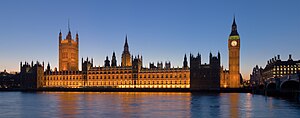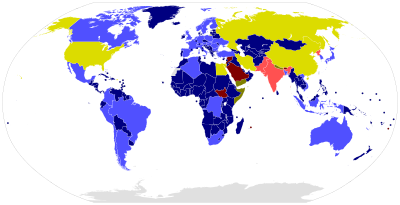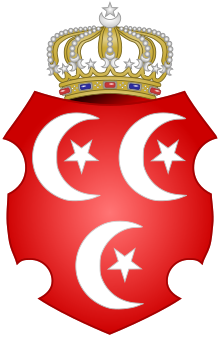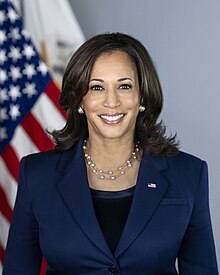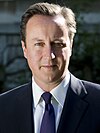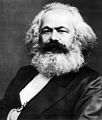Portal:Politics
| Main | Topics and categories | Tasks and projects |
The Politics portal
Politics (from Ancient Greek πολιτικά (politiká) 'affairs of the cities') is the set of activities that are associated with making decisions in groups, or other forms of power relations among individuals, such as the distribution of status or resources. The branch of social science that studies politics and government is referred to as political science.
Politics may be used positively in the context of a "political solution" which is compromising and non-violent, or descriptively as "the art or science of government", but the word often also carries a negative connotation. The concept has been defined in various ways, and different approaches have fundamentally differing views on whether it should be used extensively or in a limited way, empirically or normatively, and on whether conflict or co-operation is more essential to it.
A variety of methods are deployed in politics, which include promoting one's own political views among people, negotiation with other political subjects, making laws, and exercising internal and external force, including warfare against adversaries. Politics is exercised on a wide range of social levels, from clans and tribes of traditional societies, through modern local governments, companies and institutions up to sovereign states, to the international level.
In modern nation states, people often form political parties to represent their ideas. Members of a party often agree to take the same position on many issues and agree to support the same changes to law and the same leaders. An election is usually a competition between different parties.
A political system is a framework which defines acceptable political methods within a society. The history of political thought can be traced back to early antiquity, with seminal works such as Plato's Republic, Aristotle's Politics, Confucius's political manuscripts and Chanakya's Arthashastra. (Full article...)
Selected article
A United Nations Parliamentary Assembly is a proposed addition to the United Nations System that would allow for participation of member nations' legislators and, eventually, direct election of United Nations parliament members by citizens worldwide. The idea was raised at the League of Nations founding in the 1920s and again following the end of World War II in 1945, but remained dormant throughout the Cold War. In the 1990s and 2000s, the rise of global trade and the power of world organizations that govern it led to calls for a parliamentary assembly to scrutinize their activity. The International Campaign for the Establishment of a United Nations Parliamentary Assembly was formed in 2007 to coordinate pro-UNPA efforts. Supporters have set forth possible UNPA implementations, including promulgation of a new treaty; creation of a UNPA as a subsidiary body of the UN General Assembly; and evolution of a UNPA from the Inter-Parliamentary Union or another nongovernmental organization. Several proposals for apportionment of votes have been raised to address disparities in UN members' population and economic power. CEUNPA advocates initially giving the UNPA advisory powers and gradually increasing its authority over the UN system. Opponents cite issues such as funding, voter turnout, and undemocratic UN member nations as reasons for abandoning the project altogether.
Featured picture

Dr. Javier Solana was the High Representative for the Common Foreign and Security Policy and the Secretary-General of both the Council of the European Union (EU) and the Western European Union (WEU). This photograph shows him discussing with students of RWTH Aachen University, one day before receiving the International Charlemagne Prize of the city of Aachen.

List of all the members of the Storting in the period 2005 to 2009. The list includes all those initially elected to the Storting. Between 19 October 2005 and 30 September 2009, the Parliament of Norway consisted of 169 members from 7 parties and 19 constituencies, elected during the 2005 Norwegian parliamentary election on 11 and 12 September. The Red-Green Coalition, consisting of the Labour Party (61 members), the Socialist Left Party (15 members) and the Centre Party (11 members) gained a majority and created Stoltenberg's Second Cabinet. The majority cabinet lasted the entire session and was reelected in the 2009 election. The opposition consisted of four parties: the Progress Party (38 members), the Conservative Party (23 members), the Christian Democratic Party (11 members) and the Liberal Party (10 members).
Members of the Parliament of Norway are elected based on party-list proportional representation in plural member constituencies. This means that representatives from different political parties are elected from 19 constituencies, which are identical to the 19 counties. The electorate does not vote for individuals but rather for party lists, with a ranked list of candidates nominated by the party. This means that the person on top of the list will get the seat unless the voter alters the ballot. Parties may nominate candidates from outside their own constituency, and even Norwegian citizens currently living abroad. (Full article...)
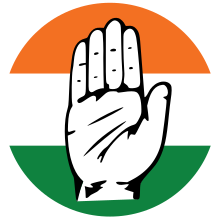
The president of the Indian National Congress is the chief executive of the Indian National Congress (INC), one of the principal political parties in India. Constitutionally, the president is elected by an electoral college composed of members drawn from the Pradesh Congress Committees and members of the All India Congress Committee (AICC). In the event of any emergency because of any cause such as the death or resignation of the president elected as above, the most senior general secretary discharges the routine functions of the president until the Working Committee appoints a provisional president pending the election of a regular president by the AICC. The president of the party has effectively been the party's national leader, head of the party's organisation, head of the Working Committee, the chief spokesman, and all chief Congress committees.
After the party's foundation in December 1885, Womesh Chandra Banerjee became its first president. From 1885 to 1933, the presidency had a term of one year only. From 1933 onwards, there was no such fixed term for the president. During Jawaharlal Nehru's premiership, he rarely held the Presidency of INC, even though he was always head of the Parliamentary Party. Despite being a party with a structure, Congress under Indira Gandhi did not hold any organisational elections after 1978. In 1978, Gandhi split from the INC and formed a new opposition party, popularly called Congress (I), which the national election commission declared to be the real Indian National Congress for the 1980 general election. Gandhi institutionalised the practice of having the same person as the Congress president and the prime minister of India after the formation of Congress (I). Her successors Rajiv Gandhi and P. V. Narasimha Rao also continued that practice. Nonetheless, in 2004, when the Congress was voted back into power, Manmohan Singh became the first and only prime minister not to be the president of the party since establishment of the practice of the president holding both positions. (Full article...)
Members are first elected to the legislature during general elections. General elections must be conducted every four years from the date of the last election. An election may also happen if the Governing party loses the confidence of the legislature, by the defeat of a supply bill or tabling of a confidence motion. (Full article...)
The governor of West Virginia is the head of government of West Virginia and the commander-in-chief of the state's military forces. The governor has a duty to enforce state laws, and the power to either approve or veto bills passed by the West Virginia Legislature, to convene the legislature at any time, and, except when prosecution has been carried out by the House of Delegates, to grant pardons and reprieves.
Since West Virginia was admitted to the Union on June 20, 1863, during the American Civil War, 34 men have served as governor. Two, Arch A. Moore Jr. (West Virginia's 28th and 30th governor) and Cecil H. Underwood (West Virginia's 25th and 32nd governor), served two nonconsecutive terms in office. The longest-serving governor was Moore, who served for three terms over twelve years. The state's first governor after admission into the Union, Arthur I. Boreman, served the most consecutive terms, resigning a week before the end of his third term. Before the state's admission, Francis Harrison Pierpont, the "Father of West Virginia," was elected governor during the Wheeling Convention of 1861. Daniel D.T. Farnsworth was senate president at the time; he filled the last seven days of Boreman's term and remains the shortest-serving governor. Underwood has the unusual distinction of being both the youngest person to be elected as governor (age 34 upon his first term in 1957) and the oldest to both be elected and serve (age 74 upon his second term in 1997; age 78 at the end of his second term in 2001). (Full article...)
Fifty-nine individuals have held the office of governor. Prior to a 1992 amendment to the state's constitution, the governor was prohibited from succeeding himself or herself in office, though four men (Isaac Shelby, John L. Helm, James B. McCreary and Happy Chandler) served multiple non-consecutive terms. Paul E. Patton, the first Kentucky governor eligible for a second consecutive term under the amendment, won his reelection bid in 1999. James Garrard succeeded himself in 1800, before the constitutional provision existed. Garrard is also the longest serving governor, serving for a total period of eight years and 90 days. In 2023 Democrat Andy Beshear became the 3rd incumbent governor in Kentucky history to be reelected to a second consecutive term. (Full article...)
Members are first elected to the legislature during general elections. General elections must be conducted every five years from the date of the last election, but the premier may ask for early dissolution of the legislative assembly. An election may also happen if the Governing party loses the confidence of the legislature, by the defeat of a supply bill or tabling of a confidence motion. (Full article...)

France was ruled by monarchs from the establishment of the Kingdom of West Francia in 843 until the end of the Second French Empire in 1870, with several interruptions.
Classical French historiography usually regards Clovis I, king of the Franks (r. 507–511), as the first king of France. However, historians today consider that such a kingdom did not begin until the establishment of West Francia, during the dissolution of the Carolingian Empire in the 800s. (Full article...)
Monarchs of the Muhammad Ali dynasty reigned over Egypt from 1805 to 1953. Their rule also extended to Sudan throughout much of this period,[a] as well as to the Levant, and Hejaz during the first half of the nineteenth century. The Muhammad Ali dynasty was founded by Pasha Muhammad Ali, an Albanian commander in the expeditionary force sent by the Ottoman Empire in 1801 to dislodge the French occupation of Egypt led by Napoleon Bonaparte. The defeat and departure of the French left a power vacuum in Egypt, which had been an Ottoman province since the sixteenth century, but in which the pre-Ottoman Mamluk military caste maintained considerable power. After a three-year civil war, Muhammad Ali managed to consolidate his control over Egypt, and declared himself Khedive of the country. The Ottoman government refused to acknowledge this title, instead recognizing Muhammad Ali by the more junior title of Wāli (roughly equivalent to a governor or viceroy) on 18 June 1805, making Muhammad Ali the successor to Ahmad Pasha in that position. In the years following his consolidation of power, Muhammad Ali extended Egypt's borders southwards into Sudan, and eastwards into the Arab-majority Mashriq, particularly the Levant. In 1840, his demand for hereditary control of Egypt and Sudan to be passed to his heirs and successors was accepted and confirmed by the Convention of London, but he was compelled to agree that, upon his death, control over his territories in the Mashreq would revert to the Porte.
Muhammad Ali had a 43-year reign, the longest in the history of modern Egypt. Termed the "father of modern Egypt," he is viewed in Egyptian historiography as the dynasty's most important ruler, due to his massive agricultural, administrative, and military reforms. His son, Ibrahim Pasha, was the shortest-reigning monarch of the dynasty. The duration of his rule varies from one source to another, depending on whether or not his reign as regent is taken into account. Contrary to what the short length of his reign might suggest, Ibrahim Pasha was far from being a historically negligible figure, although most of his significant achievements were made before his accession to the throne. His successor, Abbas Helmi I, a traditionalist described by Lord Cromer as "an Oriental despot of the worst type," reverted many of his predecessors' reform-minded measures, and is considered the most controversial ruler of his family. (Full article...)

The chancellor of Austria is the head of government of Austria, appointed by the president and viewed as the country's de facto chief executive. The chancellor chairs and leads the Cabinet, which also includes the vice-chancellor and the ministers.
Following World War I, the office was established by the Provisional National Assembly on 30 October 1918 and named state chancellor of the Republic of German-Austria, and its first holder, Karl Renner, was appointed by the State Council. After the Allied powers denied German-Austria to merge with the Weimar Republic, the country formed the federal First Austrian Republic and the office was renamed from state chancellor to federal chancellor. The first federal chancellor was Michael Mayr. There have been ten chancellors who served under the First Republic until Chancellor Engelbert Dollfuss created the authoritarian and dictatorial Federal State of Austria. Following Dollfuss's assassination by Austrian National Socialists, Kurt Schuschnigg succeeded him as chancellor and upheld the dictatorship. Schuschnigg was replaced by Arthur Seyss-Inquart, a Nazi caretaker who held the office for two days, until Austria was annexed into Nazi Germany. (Full article...)

There are 52 municipalities in Lycoming County, Pennsylvania. Under Pennsylvania law, there are three types of incorporated municipalities in Lycoming County: cities, boroughs and. Any municipality in Pennsylvania with more than 10 persons can incorporate as a borough. Any township or borough with a population of at least 10,000 can ask the state legislature to become chartered as a city. There are no unincorporated areas in the county, since all territory in Pennsylvania is incorporated.
The 52 incorporated municipalities in Lycoming County are the subject of the first list, which gives their names and etymologies, dates settled and incorporated, what they were formed from, area, population, and location within the county. Two other lists dealing with former parts of Lycoming County are included. The second list is of former incorporated townships and gives the same information as above on their current status. The third list gives information on the eighteen other Pennsylvania counties which were formed from or contain land originally in the county. (Full article...)
The Cabinet of the United States, which is the principal advisory body to the President of the United States, has had 35 African-American members altogether, with one of them serving in multiple different positions for a total of 36 cabinet appointments. Of that particular number, 25 different Black individuals held a total of 26 permanent cabinet posts, serving as Vice President or head of one of the federal executive departments, and 10 more held cabinet-level positions, which can differ under each president; no one officeholder served in both cabinet and cabinet-rank roles. The U.S. Census Bureau defines African Americans as citizens or residents of the United States who have origins in any of the black populations of Africa. The term is generally used for Americans with at least partial ancestry in any of the original peoples of sub-Saharan Africa. During the founding of the federal government, Black Americans were consigned to a status of second-class citizenship or enslaved. No African American ever held a cabinet position before the civil rights movement or the signing of the Civil Rights Act of 1964, which banned discrimination in public accommodations, employment, and labor unions.
Robert C. Weaver became the first Black-American to serve in a president's cabinet when he was appointed Secretary of Housing and Urban Development by President Lyndon B. Johnson in 1966. Patricia Roberts Harris was the first black woman to serve in a presidential cabinet when she was named to the same position by President Jimmy Carter in 1977. Two years later, Carter tapped her for Secretary of Health and Human services, thus making her the first African-American to hold two different cabinet positions. (Full article...)
Selected quote
Selected biography
David William Donald Cameron (/ˈkæmərən/; born 9 October 1966) was Prime Minister of the United Kingdom, First Lord of the Treasury, Minister for the Civil Service and Leader of the Conservative Party. Cameron represents Witney as its Member of Parliament (MP). Cameron studied Philosophy, Politics and Economics at Oxford, gaining a first class honours degree. He then joined the Conservative Research Department and became Special Adviser to Norman Lamont, and then to Michael Howard. He was Director of Corporate Affairs at Carlton Communications for seven years. A first candidacy for Parliament at Stafford in 1997 ended in defeat, but Cameron was elected in 2001 as the Member of Parliament for the Oxfordshire constituency of Witney. He was promoted to the Opposition front bench two years later, and rose rapidly to become head of policy co-ordination during the 2005 general election campaign. With a public image of a young, moderate candidate who would appeal to young voters, he won the Conservative leadership election in 2005.
Did you know (auto-generated) -

- ... that Sophie Scamps decided to enter politics after a survey from her local member of parliament failed to mention climate change?
- ... that the ideas of Albert Schädler became the founding ideas of the Progressive Citizens' Party, though he himself was opposed to the formation of political parties?
- ... that political scientist Selwyn Ryan has been called "the author of record for the ... modern political history" of Trinidad and Tobago?
- ... that Denpasar mayor I Gusti Ngurah Jaya Negara became active in politics after he was laid off from a bank due to the Asian financial crisis?
- ... that in her 2021 book White Evangelical Racism, professor of religion Anthea Butler called American evangelicalism a pro-Trump, "nationalistic political movement"?
- ... that no single political party has a mandate in a coalition government?
More did you know...
- ...that the phrase "lipstick on a pig" may have its origins in the 18th-century expression "A hog in armour is still but a hog"?
- ...that the Pirate Party of the United States was formed after a 2006 raid by the Swedish police on the servers of The Pirate Bay, a popular file sharing website?
- ...that Andrey Kirillovich Razumovsky, at the time Ambassador of the Russian Empire to the Austrian Empire, commissioned three string quartets from Beethoven?
- ...that the 1968 pamphlet Is the School House the Proper Place to Teach Raw Sex? claimed that sex education was a Communist conspiracy?
- ...that the American Society of Magazine Editors book The Best American Magazine Writing 2007 features investigative journalism about the Beslan school hostage crisis and survivors of Agent Orange?
- ...that the Libyan opposition has embraced "Zenga Zenga", an Israeli-created auto-tuned song and viral YouTube video that parodies Libyan ruler Muammar Gaddafi (pictured)?
- ...that Caedwalla of Wessex conquered southeast England during his brief 7th century reign?
- ...that the 2013 United States federal budget may impose a 23% cut on the defense budget due to the Budget Control Act of 2011, according to Secretary of Defense Leon Panetta?
In this month
- October 1, 1949 – The People's Republic of China is officially proclaimed.
- October 1, 1982 – Helmut Kohl, described as "the greatest European leader of the second half of the 20th century" by George H. W. Bush and Bill Clinton, is elected Chancellor of Germany.
- October 4, 1849 – Official founding of the Colombian Conservative Party.
- October 7, 1949 – The Democratic Republic of Germany DDR is established officially.
- October 7, 2003 – Voters recall Governor Gray Davis from office and elect actor Arnold Schwarzenegger to succeed him.
- October 10, 1911 – The Wuchang Uprising starts the Xinhai Revolution that leads to the founding of the Republic of China.
- October 10, 1919 – The Kuomintang of China was founded.
- October 27, 2005 – The political establishment in France is rocked by the spread of rioting among poor immigrant communities in suburbs of the major cities.
News and Current events
- August 11: 4 local government areas in New South Wales, Australia locked down after COVID-19 case
- August 11: Australia: AstraZeneca vaccine access expanded by Victorian government
- August 1: Australia: Victorian lockdown lifted
- July 29: Tunisia's president dismisses prime minister, suspends parliament
- July 25: Australia: Wikinews interviews Reg Kidd, mayor of the City of Orange, about COVID-19 lockdown and local government
- July 23: South Australia enters week-long lockdown to contain COVID-19 Delta variant spread
- July 21: Technological University Dublin senior lecturer Dr Lorcan Sirr speaks to Wikinews on housing market in Ireland
- July 21: Three rural councils in New South Wales, Australia enter 7-day lockdown
- July 21: Australia: Victoria lockdown extended by a week with 85 active cases recorded
- July 15: California governor signs new state budget, eligible Californians to get stimulus payments
Topics and categories
General images
Related portals
Associated Wikimedia
The following Wikimedia Foundation sister projects provide more on this subject:
-
Commons
Free media repository -
Wikibooks
Free textbooks and manuals -
Wikidata
Free knowledge base -
Wikinews
Free-content news -
Wikiquote
Collection of quotations -
Wikisource
Free-content library -
Wikiversity
Free learning tools -
Wiktionary
Dictionary and thesaurus



